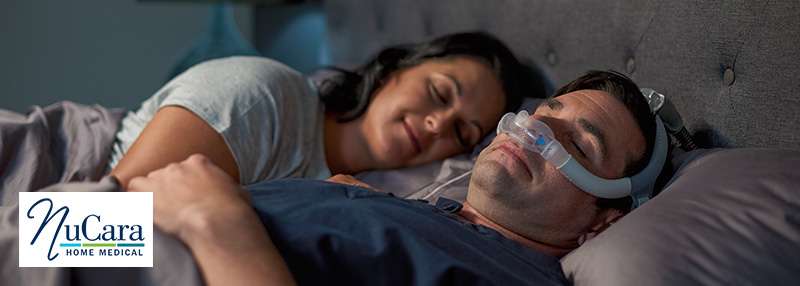NuCara Home Medical
Updated Tue November 25, 2025
Published Under: BiLevel Therapy

If you’ve recently been diagnosed with sleep apnea, or you’re struggling with your current treatment, you may be wondering what the difference is between CPAP and BiLevel (also called BiPAP) therapy.
Both therapies fall under the umbrella of PAP (Positive Airway Pressure) treatment and are highly effective for managing sleep-disordered breathing. But they work in slightly different ways and are used for different patient needs.
At NuCara Home Medical, we’re here to help you understand the basics so you can make informed decisions about your sleep therapy—and feel confident with your equipment and care plan.
Let’s explore the differences between CPAP and BiLevel therapy, how each one works, and which option might be recommended for you.
What Is CPAP Therapy?
CPAP stands for Continuous Positive Airway Pressure. It’s the most common and well-known treatment for obstructive sleep apnea (OSA), a condition where your airway repeatedly collapses or becomes blocked during sleep.
A CPAP machine delivers a steady, constant stream of air pressure through a mask to keep your airway open all night long. This helps prevent the pauses in breathing that can disrupt your sleep and cause long-term health complications.
CPAP is often the first-line therapy recommended for:
- Mild to moderate obstructive sleep apnea
- People who tolerate a single pressure setting well
- Patients without significant underlying respiratory conditions
Common features of CPAP machines include:
- Ramp settings to slowly increase pressure as you fall asleep
- Heated humidifiers for added comfort
- A variety of mask options for different sleep positions and preferences
- Simple, user-friendly controls and displays
At NuCara, we carry a wide selection of CPAP devices, masks, and accessories, and we’ll help you find the right combination to make therapy as comfortable as possible.
Explore Available PAP Supplies
What Is BiLevel (BiPAP) Therapy?
BiLevel Positive Airway Pressure, or BiPAP, is another form of PAP therapy, but instead of delivering one fixed pressure like CPAP, it provides two distinct pressure levels:
- IPAP (Inspiratory Positive Airway Pressure): Higher pressure when you breathe in
- EPAP (Expiratory Positive Airway Pressure): Lower pressure when you breathe out
This dual-pressure design makes breathing more comfortable for certain patients, especially those who struggle to exhale against a constant pressure.
BiLevel therapy is often prescribed for:
- People who cannot tolerate CPAP pressure
- Patients with central sleep apnea (CSA) or complex sleep apnea
- Individuals with underlying respiratory conditions like COPD
- People who require high pressure settings that are uncomfortable on CPAP
Some BiLevel machines also include backup rate features, automatically delivering breaths if your body doesn’t initiate one, which is a helpful function for certain neurological or central sleep disorders.
CPAP vs. BiLevel: Key Differences at a Glance
To make the comparison easy, here’s a quick side-by-side breakdown of the most important differences between CPAP and BiLevel machines:
| Feature | CPAP | BiLevel (BiPAP) |
|---|---|---|
| Pressure Delivery | Single, continuous pressure | Two levels: IPAP (in) and EPAP (out) |
| Primary Use | Obstructive sleep apnea (OSA) | OSA, CSA, COPD, complex or high-pressure cases |
| Comfort | Good for most users | Better for those who struggle to exhale |
| Machine Complexity | Simple to use | Slightly more advanced settings |
| Prescription Requirements | Standard sleep study | Often requires additional sleep testing or medical evaluation |
| Cost (Typically) | Lower | Higher (may vary by insurance) |
How to Know Which Therapy Is Right for You
The only way to know for sure whether CPAP or BiLevel is right for you is through a sleep study and a conversation with your sleep medicine provider or respiratory therapist. However, here are a few general guidelines:
CPAP may be a better fit if:
- You have been diagnosed with mild or moderate OSA
- You’re new to sleep therapy and starting with first-line treatment
- You tolerate a single pressure well and don’t have other respiratory issues
BiLevel may be needed if:
- You’ve tried CPAP but can’t get comfortable or compliant
- Your condition involves central sleep apnea or additional breathing disorders
- You need higher pressure settings that feel too intense on CPAP
At NuCara Home Medical, we work closely with patients and their providers to ensure they’re on the right therapy path. If you’ve been prescribed a BiLevel device, we’ll help you understand how it works and set it up correctly so you feel confident and supported from day one.
Contact Us Today for BiLevel Support
NuCara Makes PAP Therapy Simple and Supportive
Whether you’re using CPAP or BiLevel therapy, the right support can make all the difference. That’s where NuCara comes in.
We’re here to walk you through everything you need to stay successful with your sleep therapy, including:
- Machine setup and education
- Mask fitting for comfort and compliance
- Resupply programs to keep you stocked on filters, cushions, and tubing
- Friendly experts who answer questions and troubleshoot problems
No matter where you are in your sleep apnea journey, you don’t have to figure it out alone.
You Deserve Therapy That Works for You
Both CPAP and BiLevel therapy are effective, proven tools for treating sleep apnea. The key is finding the option that works best for your body and your breathing needs.
Still unsure which one is right for you? Or looking for help navigating your current therapy?
Reach out to NuCara Home Medical today. We’ll help you breathe easier, sleep better, and feel more in control of your care, one good night’s rest at a time.
Comments